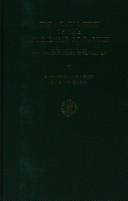| Listing 1 - 10 of 252 | << page >> |
Sort by
|
Book
Year: 1870 Publisher: Romae : Typis S. Congregationis de Propaganda Fide,
Abstract | Keywords | Export | Availability | Bookmark
 Loading...
Loading...Choose an application
- Reference Manager
- EndNote
- RefWorks (Direct export to RefWorks)
Book
ISBN: 1848883404 9004370730 Year: 2015 Publisher: Oxford, England : Inter-Disciplinary Press,
Abstract | Keywords | Export | Availability | Bookmark
 Loading...
Loading...Choose an application
- Reference Manager
- EndNote
- RefWorks (Direct export to RefWorks)
Mankind’s fascination with the Apocalypse is not new. Starting from the Hindu notions of Kali Yuga to 2012 Phenomenon, Apocalypse has been a part of our lives in the form of a cultural formation, natural threat, fictional entity, ideological construct, political fear or catastrophic end. Apocalyptic discourses underline how one culture perceives and reflects pain, trauma, loss and fear as well as indicating the ability to face and get ready for disaster. This inter-disciplinary and academic study aims to discuss the end of the world in multiple contexts where the popularity of apocalypse always reigns. In the scope of this work, readers will see the multi-dimensional nature of the Apocalypse referring more to progress rather than end or beginning, an in-between situation, a becoming, a formation; local yet global phenomenon; a product of fantasy plus a constructed reality; both an object of consumption and life consuming mechanism, an ideological presence in the absence of larger meta-narratives.
Book
ISBN: 3825312933 Year: 2003 Volume: 16 Publisher: Heidelberg Winter
Abstract | Keywords | Export | Availability | Bookmark
 Loading...
Loading...Choose an application
- Reference Manager
- EndNote
- RefWorks (Direct export to RefWorks)
Book
Year: 1976 Publisher: Berlin : Akademie-Verlag,
Abstract | Keywords | Export | Availability | Bookmark
 Loading...
Loading...Choose an application
- Reference Manager
- EndNote
- RefWorks (Direct export to RefWorks)
Book
ISBN: 9781443878807 1443878804 9781443872379 1443872377 Year: 2015 Publisher: Newcastle upon Tyne Cambridge Scholars Publishing
Abstract | Keywords | Export | Availability | Bookmark
 Loading...
Loading...Choose an application
- Reference Manager
- EndNote
- RefWorks (Direct export to RefWorks)
Apocalyptic Projections have been pondered since Biblical times. Theories abounded in an attempt to prepare for calamity and plan for the future. Worldwide concern regarding a twenty-first century apocalypse, related to the 2012 Mayan Apocalyptic prediction, sparked renewed interest. Even though the concept of apocalypse evokes images of total oblivion, threads of possibility and redemption offer a potential fabric of hope. The majority of the papers included in Apocalyptic Projections were p...
Book
ISBN: 9781433104190 1433104199 Year: 2009 Publisher: Frankfurt am Main [etc.] Peter Lang
Abstract | Keywords | Export | Availability | Bookmark
 Loading...
Loading...Choose an application
- Reference Manager
- EndNote
- RefWorks (Direct export to RefWorks)

ISBN: 9004076085 9789004076082 9004662529 9789004662520 Year: 1986 Publisher: Leiden: Brill,
Abstract | Keywords | Export | Availability | Bookmark
 Loading...
Loading...Choose an application
- Reference Manager
- EndNote
- RefWorks (Direct export to RefWorks)
Book
ISBN: 9783866883208 386688320X 3866883218 Year: 2013 Volume: 490 Publisher: München: Sagner,
Abstract | Keywords | Export | Availability | Bookmark
 Loading...
Loading...Choose an application
- Reference Manager
- EndNote
- RefWorks (Direct export to RefWorks)
Die Apokalypse des Paulus gehört zu den erfolgreichsten Literaturwerken aller Zeiten. Im 2. Jahrhundert geschaffen, wurde sie noch bis ins 20. Jahrhundert handschriftlich weiterverbreitet; über 300 Textzeugen sind zwischen Irland und Armenien, Skandinavien und Äthiopien erhalten geblieben, davon fast ein Drittel allein im Raum der Slavia Orthodoxa. Obwohl die wissenschaftliche Beschäftigung mit dem slavischen Text schon 1858 in Russland ihren Anfang genommen hat, ist die Einordnung der slavischen Tradition in die Gesamtüberlieferung dieses wichtigen Apokryphons, das das Bild der christlichen Welt von Himmel und Hölle entscheidend geprägt hat, bis heute ein Desiderat der Forschung.Die vorliegende Arbeit versucht, hier neue Anstöße zu geben, und wendet sich dabei nicht nur an Slavisten, sondern auch an Theologen, Vertreter der Wissenschaft vom Christlichen Orient, Byzantinisten und Rumänisten, denen der Zugang durch die Beifügung der Rekonstruktion der ältesten slavischen Version sowie deren Übersetzung ins Deutsche erleichtert wird.
Apocalypse of Paul --- Paulus ap. --- Apocalypsis
Book
ISBN: 9789004430617 9789004430624 900443061X 9004430628 Year: 2022 Publisher: Leiden Boston
Abstract | Keywords | Export | Availability | Bookmark
 Loading...
Loading...Choose an application
- Reference Manager
- EndNote
- RefWorks (Direct export to RefWorks)
The Apocalypse of Abraham is a pseudepigraphal work that narrates Abraham's rejection of idol worship and his subsequent ascent to heaven, where he is shown eschatological secrets through angelic mediation. This fascinating text was only preserved in Old Church Slavonic and must be studied as both a medieval Christian and an ancient Jewish text. This monograph addresses the following questions: -Why were medieval Slavs translating and reading Jewish pseudepigrapha? -How much, if at all, did they emend or edit the Apocalypse of Abraham ? -When in antiquity was it most likely written? -What were its ancient Jewish social and theological contexts?.
Ancient Judaism --- Biblical Studies --- Apocalypse of Abraham --- Knigy otkrovlenii︠a︡ Avrami︠e︡ --- Abraham, Apocalypse of --- Criticism, interpretation, etc. --- 229*224 --- 229*224 Apocalypse van Abraham --- Apocalypse van Abraham
Book
Abstract | Keywords | Export | Availability | Bookmark
 Loading...
Loading...Choose an application
- Reference Manager
- EndNote
- RefWorks (Direct export to RefWorks)
| Listing 1 - 10 of 252 | << page >> |
Sort by
|

 Search
Search Feedback
Feedback About UniCat
About UniCat  Help
Help News
News